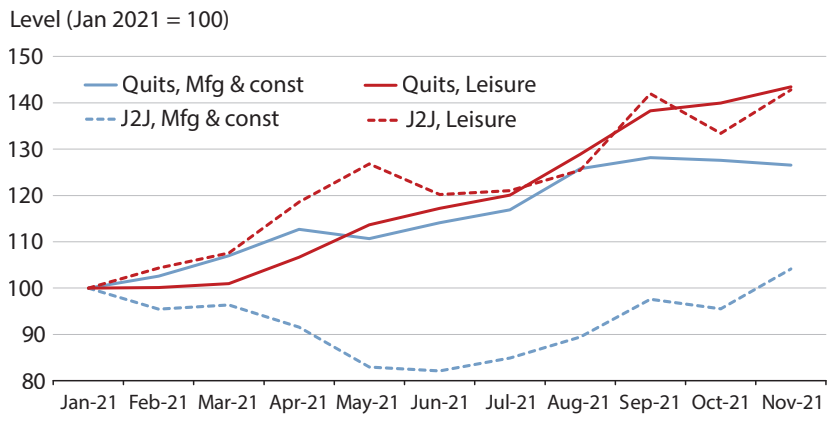The Great Resignation Hypothesis: A Look at Two Industries
The phrase the “Great Resignation,” which refers to a large number of workers quitting their jobs, became popular as the economy recovered from the COVID-19 recession. An Economic Synopses essay from March also looked at what the authors call the “Great Reallocation,” which refers to workers transferring from one job to another.
“Not all quits are created equal. Quits due to job switches are often associated with the benefit of stimulating wage growth, whereas quits to unemployment or out of the labor force can create labor shortages,” wrote St. Louis Fed Economist Serdar Birinci and Research Associate Aaron Amburgey.
“There has been a sizeable increase in the number of quits since January 2021, but the data tell us that in certain industries, such as leisure, this increase is due to an increase in job-to-job transitions, which have led to real wage growth,” they wrote.
Comparison of Two Industries
To examine the Great Resignation hypothesis, the authors looked at quits and job-to-job transitions in the manufacturing and construction industry and in the leisure industry, both of which have high job mobility. They looked at the period January 2021 through November 2021.
They found that both industries experienced a sizeable increase in quits, but the job-to-job transitions did not behave the same way in both (as shown in the figure below, which can be found in the Economic Synopses essay). In particular, the authors noted that:
- In manufacturing and construction, job-to-job transitions fell far behind quits.
- In leisure, job-to-job transitions rose at about the same pace as quits.
“Overall, these results suggest that most quits in the leisure industry were driven by job switches, whereas in manufacturing and construction they were not,” Birinci and Amburgey wrote.
Quits and Job-to-Job Transitions

NOTES: Data are seasonally adjusted and smoothed with a three-month moving average. Levels are normalized so that January 2021 = 100. J2J refers to job-to-job transitions.
SOURCES: Job Openings and Labor Turnover Survey, Current Population Survey and authors’ calculations.
Impact on Wages
Given the positive relationship between job-to-job transitions and wage growth, the authors also examined wage growth in these two industries over the same period to see whether it was stronger in leisure than in manufacturing and construction. Indeed, Birinci and Amburgey found that to be the case.
They noted that:
- In manufacturing and construction, average nominal wages increased by about 4% between January and November 2021 (and actually decreased by about 2% after adjusting for inflation).
- In leisure, average nominal wages increased by almost 13% (and increased by about 6% after adjusting for inflation).
“These results are consistent with the hypothesis that the larger the increase in job-to-job transitions, the larger the wage growth,” they wrote.
(Earlier this month, Serdar Birinci and Research Associate Ngân Trần further investigated the Great Resignation with an On the Economy post that analyzed the quit rate by certain occupational groups.)
Citation
ldquoThe Great Resignation Hypothesis: A Look at Two Industries,rdquo St. Louis Fed On the Economy, June 28, 2022.
This blog offers commentary, analysis and data from our economists and experts. Views expressed are not necessarily those of the St. Louis Fed or Federal Reserve System.
Email Us
All other blog-related questions

